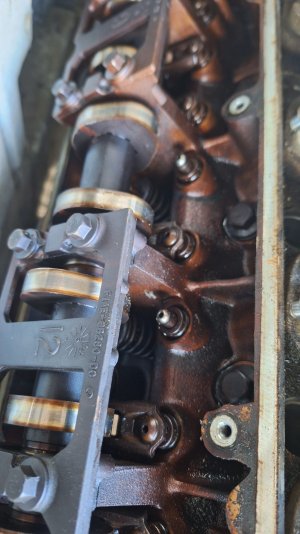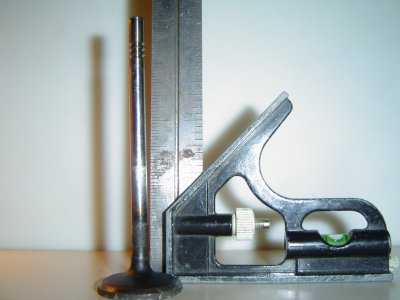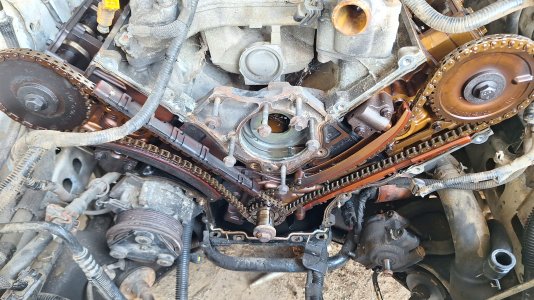Just a fore-note... I'm assuming that most of you know what I mean when I say "gallop" and not the gait of a horse. I mean that when you crank the engine, the pitch of the starter changes at different stages of crank rotation instead of being steady and uniform.
My most recent acquisition, a 95 4.6 Thunderbird, it has the worst uneven cranking sound I've ever heard. It won't start because it need a fuel pump. I mean, there hasn't been one that I've bought yet that didn't. With as many as I have I should probably keep several in stock, but I digress.
When I went to look at this thing before I bought it, the guy was trying to use starting fluid to make it fire. Maybe he did, I don't know, but he said it would start but not stay running...duh! When he cranked it for me it backfired through the throttle body as he had the intake tube off. I told him to stop, immediately thinking that the cam timing had jumped. I don't know why but that was my initial thought.
When I got it home, first thing I checked was the firing order and coil pack wiring. It was correct. I then replaced the starter and installed crimp-on battery terminals to straighten out the half-assed attempt at shitty aftermarket terminals. And then I cranked it. I may have to record a sound clip and uploaded it. It was horrible! So then I removed all the plugs. They were all carbon fouled due to an extremely rich mixture. Seeing the shape of the exhaust system, I can believe it.
I then cranked the car with plugs removed and it sounded as you would expect. Everything uniform with no gallop.
So I should know this, and I think the answer is yes, BUT....is the 4.6 an interference engine? If this was indeed the case than I think my initial impression may be correct. There certainly are other things that could cause the uneven crank like maybe a rubbed-off cam lobe, but I've never heard of this happening with a roller cam. I suppose there could be broken valve train components, but I don't think this would cause a backfire.
I'm leaning towards broken timing chain tensioners and if this is an interference engine, that means I could have bent valves and/or holes in pistons which would certainly cause a gallop. A stuck valve could certainly cause a backfire. Some advice on my troubleshooting theory and how to proceed would be helpful. I think the next thing I'm going to do is pull the valve covers and take a look. Such a fun thing on these cars...NOT.
Drop me a line and let me know what you think...Thanks!
My most recent acquisition, a 95 4.6 Thunderbird, it has the worst uneven cranking sound I've ever heard. It won't start because it need a fuel pump. I mean, there hasn't been one that I've bought yet that didn't. With as many as I have I should probably keep several in stock, but I digress.
When I went to look at this thing before I bought it, the guy was trying to use starting fluid to make it fire. Maybe he did, I don't know, but he said it would start but not stay running...duh! When he cranked it for me it backfired through the throttle body as he had the intake tube off. I told him to stop, immediately thinking that the cam timing had jumped. I don't know why but that was my initial thought.
When I got it home, first thing I checked was the firing order and coil pack wiring. It was correct. I then replaced the starter and installed crimp-on battery terminals to straighten out the half-assed attempt at shitty aftermarket terminals. And then I cranked it. I may have to record a sound clip and uploaded it. It was horrible! So then I removed all the plugs. They were all carbon fouled due to an extremely rich mixture. Seeing the shape of the exhaust system, I can believe it.
I then cranked the car with plugs removed and it sounded as you would expect. Everything uniform with no gallop.
So I should know this, and I think the answer is yes, BUT....is the 4.6 an interference engine? If this was indeed the case than I think my initial impression may be correct. There certainly are other things that could cause the uneven crank like maybe a rubbed-off cam lobe, but I've never heard of this happening with a roller cam. I suppose there could be broken valve train components, but I don't think this would cause a backfire.
I'm leaning towards broken timing chain tensioners and if this is an interference engine, that means I could have bent valves and/or holes in pistons which would certainly cause a gallop. A stuck valve could certainly cause a backfire. Some advice on my troubleshooting theory and how to proceed would be helpful. I think the next thing I'm going to do is pull the valve covers and take a look. Such a fun thing on these cars...NOT.
Drop me a line and let me know what you think...Thanks!



